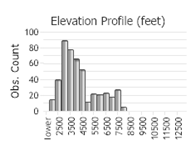View in other NatureServe Network Field Guides
NatureServe
Montana
Utah
Wyoming
Idaho
Wisconsin
British Columbia
South Carolina
Yukon
California
New York
Paddle-tailed Darner - Aeshna palmata
Native Species
Global Rank:
G5
State Rank:
S5
Agency Status
USFWS:
USFS:
BLM:
External Links
General Description
The Paddle-tailed Darner is a member of the family Aeshnidae. Darners are among the largest and fastest-flying North American dragonflies, 2 1/4-4 3/4" (57-120 mm) long. Paddle-tailed Darners are found state wide from the mountians to the prairies. Preferred habitat includes a variety of lakes and ponds with dense shoreline vegetation, marshy or boggy ponds, fens, and saline ponds, as well as slow-moving streams (Nikula et al. 2002, Paulson 2009, Dunkle 2000). Associated Wetland ecological systems are numerous: Western Emergent Marsh, Northern Rocky Mountain Wooded Vernal Pool and the Rocky Mountain Subalpine-Montane Fen, Great Plains Open Freshwater Depressional Wetland, Great Plains Prairie Pothole,and potentially the Great Plains Saline Depression Wetland since these dragons can tolerate saline conditions.
Species Range
Montana Range
Range Descriptions

 Native
Native
Range Comments
Our most common pond and wetland dragonfly, found throughout Montana.
Observations in Montana Natural Heritage Program Database
Number of Observations: 600
(Click on the following maps and charts to see full sized version)
Map Help and Descriptions
Relative Density

Recency



 (Observations spanning multiple months or years are excluded from time charts)
(Observations spanning multiple months or years are excluded from time charts)
Habitat
Paddle-tailed Darners habitats include shaded lakes, ponds, and slow-flowing streams usually in forested areas, but they can also be found in more arid regions. Bogs and fens are also used as breeding sites (Dunkle 2000, Paulson 2009). Away from water, this species tends to hunt along thicket edges until evening (Dunkle 2000).
National Vegetation Classification System Groups Associated with this Species
Wetland and Riparian
Alkaline - Saline Wetlands
Alpine Riparian and Wetland
Peatland
Riparian and Wetland Forest
Riparian Shrubland
Wet Meadow and Marsh
Food Habits
Larvae feed on a wide variety of aquatic insects, such as mosquito larvae, other aquatic fly larvae, mayfly larvae, and freshwater shrimp. They will also eat very small fish and tadpoles.
Adult- The dragonfly will eat almost any soft-bodied flying insect including mosquitoes, flies, small moths, mayflies, and flying ants or termites.
Reproductive Characteristics
Male Paddle-tailed Darners make short patrols of shorelines near trees in the open or between vegetation searching for females. They hover for long periods between patrol flights often returning to same open area along shoreline. Copulation is in flight over open water and mated pair then flies toward edge of wetland area. The pair will perch on trees or nearby vegetation until female begins oviposition. She lays eggs in grass blades, cattails, bulrushes and irises above waterline. Floating logs at waterline is another oviposition option (Dunkle 2000, Paulson 2009).
Stewardship Responsibility
References
- Literature Cited AboveLegend:
 View Online Publication
View Online Publication Dunkle, S.W. 2000. Dragonflies through binoculars: A field guide to dragonflies of North America. New York, NY. Oxford University Press. 266 pp.
Dunkle, S.W. 2000. Dragonflies through binoculars: A field guide to dragonflies of North America. New York, NY. Oxford University Press. 266 pp. Nikula, B., J. Sones, D.W. Stokes, and L.Q. Stokes. 2002. Stokes beginner's guide to dragonflies and damselflies. Boston: Little, Brown. 159 pp.
Nikula, B., J. Sones, D.W. Stokes, and L.Q. Stokes. 2002. Stokes beginner's guide to dragonflies and damselflies. Boston: Little, Brown. 159 pp. Paulson, D.R. 2009. Dragonflies and Damselflies of the West. Princeton University Press, Princeton. 535 pp.
Paulson, D.R. 2009. Dragonflies and Damselflies of the West. Princeton University Press, Princeton. 535 pp.
- Additional ReferencesLegend:
 View Online Publication
View Online Publication
Do you know of a citation we're missing? Nelson, Howard E. 1953. The summer dragonflies of Flathead Valley, Montana. M.A. Thesis. University of Montana. Missoula, MT.
Nelson, Howard E. 1953. The summer dragonflies of Flathead Valley, Montana. M.A. Thesis. University of Montana. Missoula, MT. Sater, S. 2022. The insects of Sevenmile Creek, a pictorial guide to their diversity and ecology. Undergraduate Thesis. Helena, MT: Carroll College. 242 p.
Sater, S. 2022. The insects of Sevenmile Creek, a pictorial guide to their diversity and ecology. Undergraduate Thesis. Helena, MT: Carroll College. 242 p.
- Web Search Engines for Articles on "Paddle-tailed Darner"
- Additional Sources of Information Related to "Insects"





